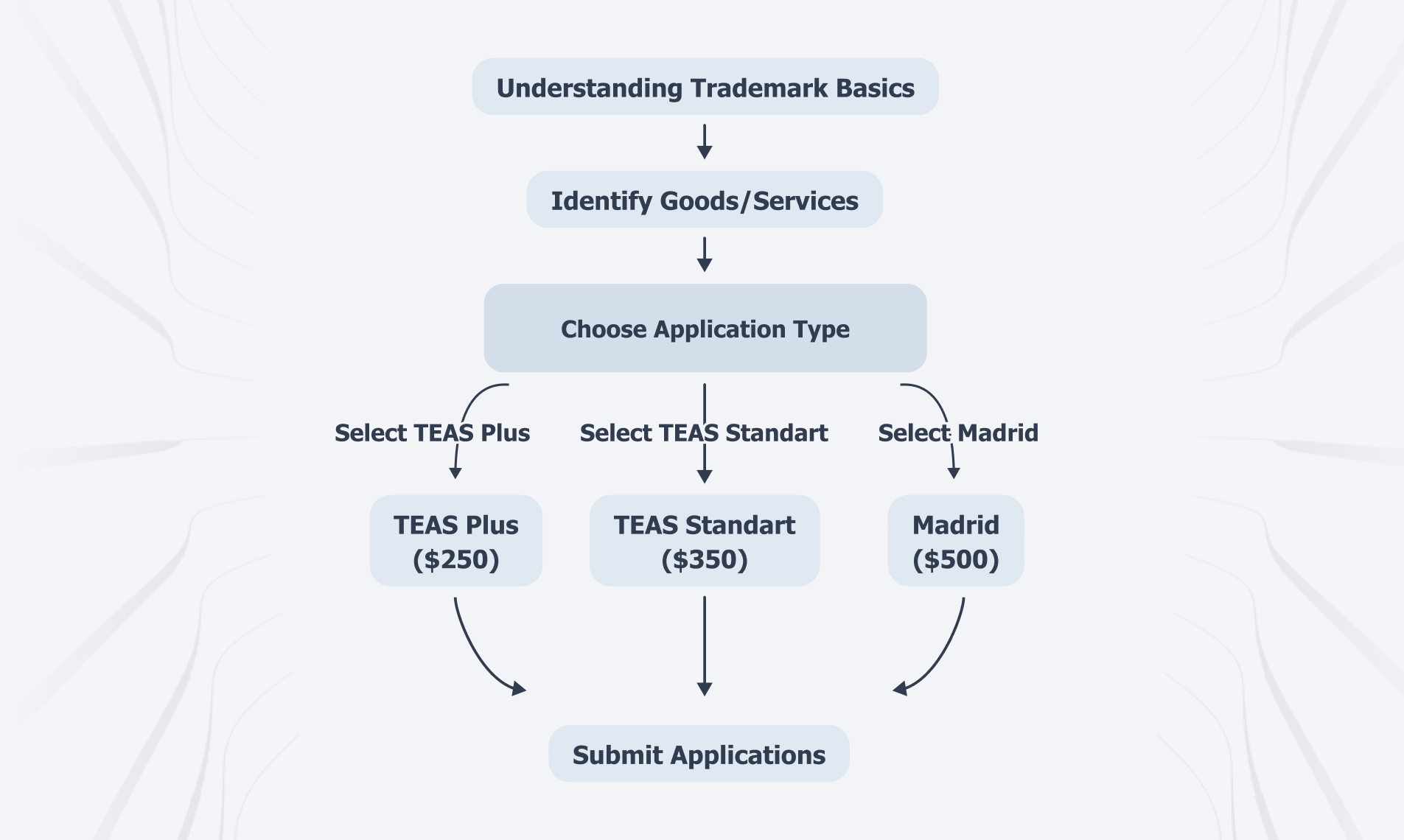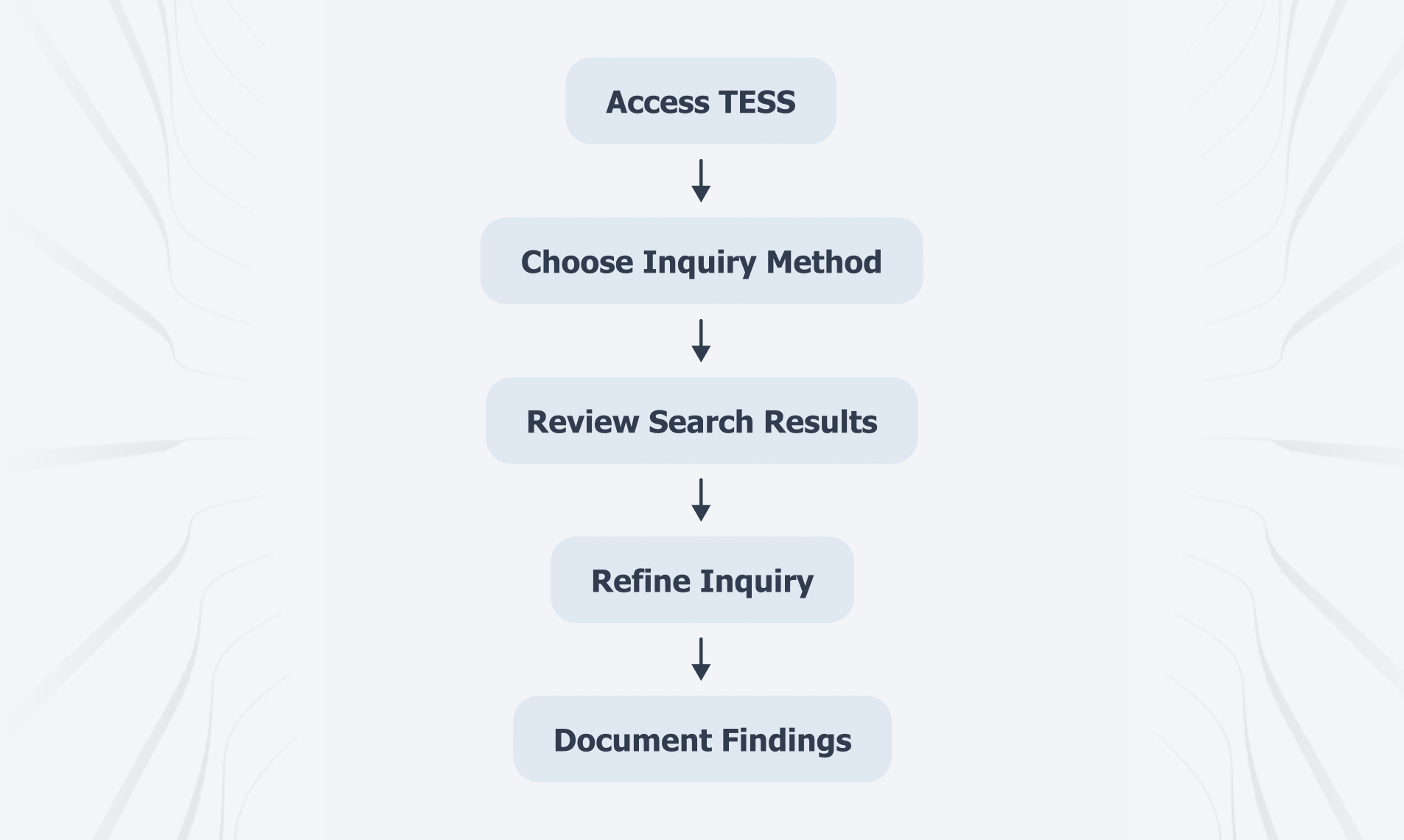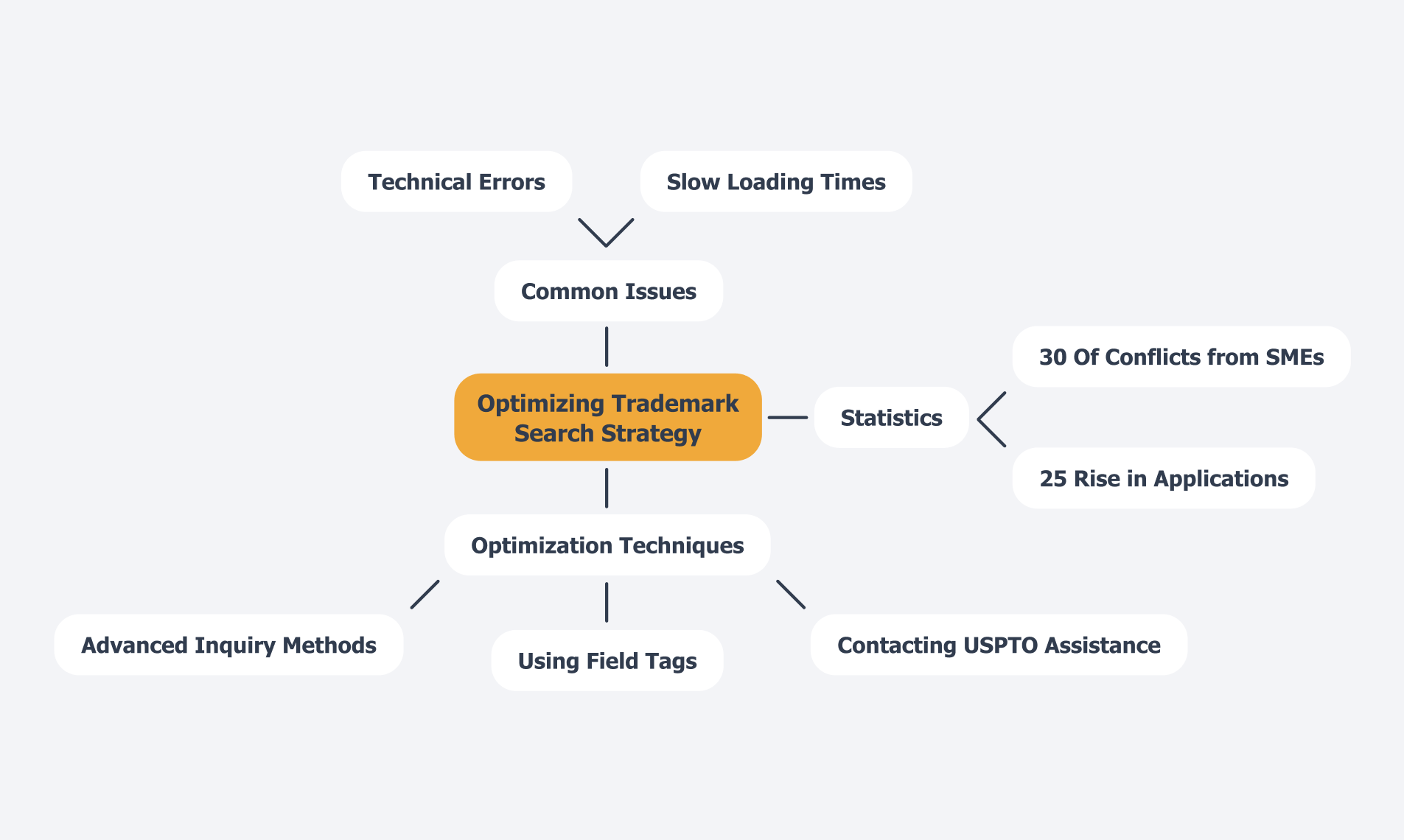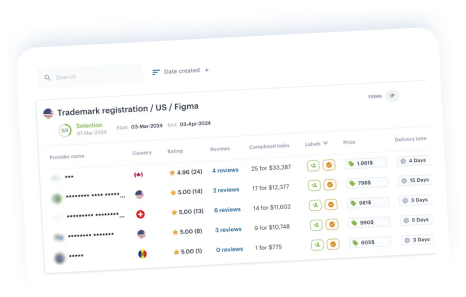Overview
Mastering the USPTO trademark search process is achievable in three definitive steps:
- Understanding trademark basics
- Conducting a thorough trademark search utilizing the USPTO’s TESS system
- Troubleshooting common issues to optimize search strategies
This article outlines essential procedures and best practices that enhance the effectiveness and efficiency of the trademark registration process.
By selecting appropriate inquiry methods, documenting findings meticulously, and utilizing field tags, you can significantly improve your search outcomes. These strategies not only streamline the process but also bolster your confidence in navigating the complexities of intellectual property management.
Introduction
In the dynamic realm of intellectual property, grasping the complexities of trademark registration is crucial for businesses seeking to forge a robust brand identity. Trademarks act as essential identifiers for goods and services, making their protection increasingly vital, especially in the technology sector, where applications have surged dramatically.
Although navigating the intricacies of the United States Patent and Trademark Office (USPTO) can seem overwhelming, possessing the right knowledge and strategies empowers companies to safeguard their innovations effectively.
This article explores the foundational elements of trademarks, outlines step-by-step procedures for conducting comprehensive searches, and addresses common challenges, equipping businesses with the essential tools to confidently navigate the trademark registration process.
Understand Trademark Basics and USPTO Functions
A brand serves as a unique identifier for goods or services, encompassing words, phrases, symbols, or designs. The United States Patent and Trademark Office (USPTO) plays a crucial role in the documentation of brand names, safeguarding against potential violations of existing marks.
By 2025, the brand registration landscape has evolved significantly, with total filings showing a robust increase in applications, especially within the technology sector, where brand applications have surged by 25% over the past five years. Notably, applications related to blockchain technology saw a 15% increase in 2023, underscoring the innovation driving new enterprises, and understanding the fundamentals of brand protection is essential before conducting a USPTO search trademark. This knowledge clarifies what to seek and highlights the importance of brand symbols in establishing identity and protecting intellectual property.
Trademarks enable businesses to distinguish their products and services in a competitive market, which is vital for cultivating a strong brand presence. For instance, effective brand management practices, as illustrated by the OPIA Dashboard case study, provide insights into the fiscal year’s brand data, allowing businesses to efficiently track their IP activities and make informed decisions using the USPTO search trademark.
In 2025, the USPTO continues to enhance its functions, offering various application types:
- TEAS Plus at $250 per class
- TEAS Standard at $350 per class
- Madrid applications at $500 per class
These updates reflect the agency’s commitment to simplifying the brand name application process, making it more accessible for businesses.
Furthermore, utilizing iPNOTE’s AI-powered tools can streamline the management of your intellectual property portfolio, enabling corporate IP managers to efficiently track progress, manage tasks, and collaborate with service providers.
As businesses navigate the complexities of brand registration, understanding these fundamentals is crucial for achieving successful outcomes.

Follow Step-by-Step Procedures for Conducting a Trademark Search
- Access the USPTO Trademark Electronic Search System (TESS): Begin by navigating to the TESS website, the essential platform for searching registered marks. This tool is crucial for any business looking to protect its intellectual property by conducting a uspto search trademark.
- Choose Your Inquiry Method: Select between the ‘Basic Word Mark Inquiry’ for straightforward queries or the ‘Advanced Inquiry’ for more intricate investigations utilizing field tags. For example, to locate brands that contain the term ‘USPTO’, simply enter ‘USPTO’ into the search bar.
- Review Search Results: Carefully analyze the results. Focus on trademarks that may resemble your proposed mark in appearance, sound, or meaning. It’s essential to consider the related products and offerings to identify any possible conflicts.
- Refine Your Inquiry: If necessary, enhance your investigation by adding more keywords or narrowing your focus to specific classes of goods or services. The tips provided by the USPTO search trademark can assist in streamlining your efforts.
- Document Your Findings: Maintain a detailed record of your search results, emphasizing any brands that could present conflicts along with their relevant details for future reference. This documentation is essential for informed decision-making in your brand strategy. A recent case study illustrated how a systematic method for brand searching resulted in successful registrations, highlighting the significance of comprehensive initial evaluations.
Make It Even Easier with iPNOTE Global AI Trademark Search: For a faster, fully automated experience, simply register and run our AI-powered Trademark Search tool. In seconds, it will scan USPTO, EUIPO, WIPO, and other global databases, deliver a clear similarity score, flag potential conflicts, and generate a concise report—no manual setup required.
In 2025, the success rates of brand searches using TESS have shown significant improvement, with many companies refining their search strategies based on best practices. As Gopal Singh Rawat from Sagacious IP mentions, “At Sagacious IP, we recognize the importance of brand protection, which is why we provide a specialized service aimed at offering clients the information they require prior to applying for brands.”
Furthermore, the firm has noted over 50,000 branding scenarios, reinforcing the importance of the outlined steps. Regular legal audits and staying updated on current IP laws are recommended to safeguard your creations effectively. By adhering to these steps, businesses can manage the brand protection process with enhanced confidence and efficiency through a uspto search trademark.

Troubleshoot Common Issues and Optimize Your Search Strategy
Frequent problems during brand inquiries often involve difficulties in identifying pertinent brands and technical issues related to the uspto search trademark. Users may encounter errors or slow loading times, which can be exacerbated by the aggregate number of registered marks differing due to multiple ownership registrations. To mitigate these issues, clearing your browser cache or switching to a different browser can often resolve technical glitches.
To enhance your uspto search trademark inquiry strategy, utilize field tags effectively. For instance, using ‘CM:’ enables you to look for combined marks, while ‘GS:’ concentrates on goods and services. Remember to capitalize these field tags to enhance retrieval accuracy and results.
Utilizing sophisticated inquiry methods can greatly enhance your results in a uspto search trademark. The uspto search trademark provides features like wildcards and logical operators, allowing you to expand or refine your parameters effectively. These tools are essential for navigating the complexities of brand databases.
If you continue to face challenges, do not hesitate to reach out to the USPTO’s Trademark Assistance Center regarding your uspto search trademark. Their specialists can offer valuable advice on navigating the retrieval system and interpreting your outcomes, ensuring you make informed choices.
Statistics indicate that the technology sector has experienced a 25% rise in brand applications over the past five years, underscoring the growing significance of effective brand management. Furthermore, small and medium-sized enterprises (SMEs) represent 30% of intellectual property conflicts, emphasizing the need for accessible legal resources and strong investigation strategies for companies of all scales. As industry leaders stress, “Enhancing your brand inquiry approach is essential for reducing conflicts and ensuring adherence in a swiftly changing market.”
Additionally, it is essential to recognize that registered marks are categorized by basis of ownership: domestic, foreign, or by request for protection under the Madrid Protocol. This classification offers further context for comprehending registration complexities. By implementing these optimization techniques and staying informed about common issues faced during trademark searches in 2025, companies can enhance their trademark search processes and reduce the likelihood of disputes.

Conclusion
Understanding the intricacies of trademark registration is imperative for businesses aiming to establish and protect their brand identity.
Trademarks serve as essential identifiers in a competitive market, with the USPTO playing a pivotal role in safeguarding these marks. The significant rise in trademark applications, particularly in the technology sector, underscores the growing importance of intellectual property protection in fostering innovation.
Following the outlined step-by-step procedures for conducting a thorough trademark search not only aids in identifying potential conflicts but also empowers businesses to make informed decisions regarding their branding strategies. By leveraging resources like the USPTO’s TESS and implementing effective search techniques, companies can enhance their chances of successful trademark registration.
Moreover, addressing common challenges and optimizing search strategies is crucial in navigating the complexities of trademark registration.
With a proactive approach, businesses can minimize disputes and ensure compliance in an ever-evolving market landscape. Prioritizing trademark management and understanding the nuances of the registration process enables companies to confidently safeguard their intellectual property and build a strong foundation for their brand’s future.
Secure Your Brand’s Future with Effortless Trademark Registration. Start now with iPNOTE and simplify your journey to intellectual property protection.
Frequently Asked Questions
What is a brand?
A brand serves as a unique identifier for goods or services, encompassing words, phrases, symbols, or designs.
What role does the USPTO play in brand registration?
The United States Patent and Trademark Office (USPTO) is crucial for documenting brand names and safeguarding against potential violations of existing marks.
How has the brand registration landscape changed by 2025?
By 2025, there has been a significant increase in total filings for brand applications, particularly in the technology sector, which saw a 25% surge over the past five years.
What specific increase was noted in blockchain technology applications in 2023?
Applications related to blockchain technology saw a 15% increase in 2023.
Why is understanding brand protection fundamentals important?
Understanding brand protection fundamentals is essential before conducting a USPTO trademark search, as it clarifies what to seek and emphasizes the importance of brand symbols in establishing identity and protecting intellectual property.
How do trademarks benefit businesses?
Trademarks enable businesses to distinguish their products and services in a competitive market, which is vital for cultivating a strong brand presence.
What are the different application types offered by the USPTO in 2025?
The USPTO offers the following application types: 1. TEAS Plus at $250 per class 2. TEAS Standard at $350 per class 3. Madrid applications at $500 per class.
How does iPNOTE assist with intellectual property management?
iPNOTE’s AI-powered tools streamline the management of intellectual property portfolios, allowing corporate IP managers to efficiently track progress, manage tasks, and collaborate with service providers.
What is the importance of effective brand management practices?
Effective brand management practices, such as those illustrated by the OPIA Dashboard case study, provide insights into brand data, allowing businesses to track their IP activities and make informed decisions using the USPTO trademark search.
What is the trademark registration process?
The trademark registration process involves understanding trademarks, identifying goods/services, choosing an application type based on cost, and submitting the application, all of which help simplify the process of protecting a brand.






